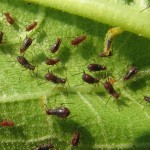 |
Collage with several species of lady
beetles
© 2006 Beatriz Moisset
|
Frank E. Lutz, an entomologist and gardener, wrote “A Lot of Insects” in which he tells us about all the six-legged fauna of his large suburban yard. He noticed that native plants were good at attracting what he called guests and residents of this realm. His property was located near the center of a small town not far from New York City. In the course of a few years, Dr. Lutz collected and identified every kind of insect that he found in his property, a grand total of 1,402 different species. Before you shrink in horror at that staggering number of buggy creatures, let me tell you that Dr. Lutz was a fine gardener and, while he was sorting out and studying the little creatures in his garden, he was winning numerous gardening awards. And he had the insects to thank for such a healthy garden.
The fact is that many, probably most, insects are invaluable components of the ecosystem. It is wise to learn to recognize and appreciate these gardener friends. A good dose of curiosity may allow you to enjoy their intriguing, sometimes perplexing, comings and goings if you manage to overcome your bias against insects.
Let us leave aside for now the pollinators, the decomposers and the ones that serve as food for birds, all of them important, and let us concentrate on the ones that fight the bad guys. These are the so-called biological controls or biocontrols for short. By feeding on other insects they provide checks and balances in the flora and fauna of the garden. Let us use aphids as an example. Aphids are ubiquitous in small numbers in every garden whether we notice them or not. What is keeping the lid on them so we don’t see outbreaks everywhere and everyday?
In the fight against aphids, the first one that comes to mind is the ladybug. It is more correct to call them lady beetles because there are many different ones and because they are actually beetles, not bugs. Lady beetles, the adult ones, are called cute and pretty. They are roundish, brightly colored mostly in orange and black or red and black. They are found frequently among one of their favorite dishes, aphids. However few of us notice the larvae of these beetles, funny looking little alligators. Some people squash them mercilessly, not knowing that they are killing their garden friends.
 |
Spotted lady beetle larva
(Coleomegilla maculata)
© Beatriz Moisset
|
Obviously she didn’t get beyond the words “aphid” and “larva”. Another explanation was in order: “This is a ladybug baby. Let it be, and it will become the pretty adult you love. Kill it and the aphids will thank you.” She finally understood and made peace with her visitors.
 |
Syrphid fly or hover fly
(Syrphus)
© Beatriz Moisset
|
 |
Larva of syrphid fly
feeding on aphids
© Beatriz Moisset
|
They can reach a size somewhat larger than the aphids among which you find them, but are usually green and plain looking, not very conspicuous. The mother fly lays its eggs in the midst of a growing aphid colony and the blind maggots search for their food, sucking the little pests dry one after another. Aphids tend to ignore these predators. I have seen them walking all over one of the hungry maggots unaware of the danger.
 |
Parasitic wasp, Aphidiinae,
and aphid
|
 |
Lacewing larva
© Beatriz Moisset
|
Lacewing larvae are also unsung heroes of the battle against aphids. The adults are delicate looking, hence the name of lacewings. The larvae, about the same size of the aphids in which they feed, have formidable jaws. Usually their color matches that of the aphids and that is how they go unnoticed.
 |
Larva of aphid midge (Aphidoletes)
amid a colony of aphids
© Beatriz Moisset
|
Another member of this army is a tiny fly, the aphid midge, which also lays eggs near aphids and, you guessed it, the larvae feed on them. There are many others but I will just mention a couple whose names match the militaristic language used here: some soldier beetles such as Podabrus and a stink bug, the spined soldier bug (Podisus maculiventris). And we thought that all stink bugs were terrible!
 |
Soldier beetle
(Podabrus)
© Beatriz Moisset
|
 |
Spined soldier bug
(Podisus maculiventris)
© Beatriz Moisset
|
Doug Tallamy talks frequently about turning all our gardens into nature preserves of sorts, what he calls the Homegrown National Park, with an abundance of wildlife. Frank Lutz created a garden with a good biological balance by allowing the presence of plant eaters and their biocontrols and also by cultivating a number of native plants. It seems that his yard was an early precursor of the Homegrown National Park.
© 2012, Beatriz Moisset. First published in Native Plants and Wildlife Gardens.
